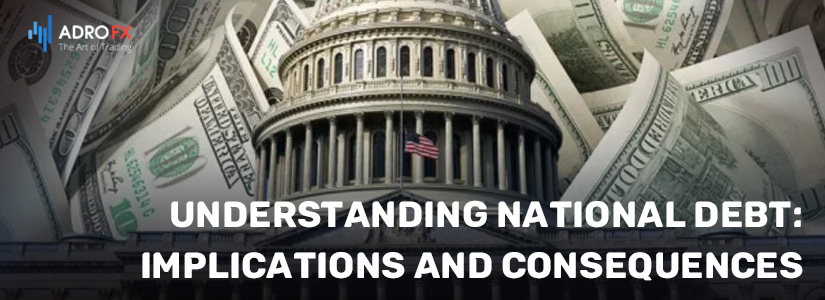Understanding National Debt: Implications and Consequences

Recently, all the headlines were focused on the US debt ceiling, sparking discussions and concerns about the state of the nation's finances. The US debt has become a topic of great importance, drawing attention from economists, policymakers, and the public alike. But why is everyone talking about US debt? The answer lies in the significant implications it holds for the economy, financial stability, international relations, and the political landscape.
While it can stimulate economic growth and enable counter-cyclical policies, high levels of debt can lead to increased borrowing costs, reduced fiscal flexibility, and macroeconomic instability.
Understanding the key drivers of the national debt is essential. Factors such as government spending, tax policies, interest rates, economic performance, and demographic trends contribute to debt accumulation. External factors like global economic conditions and financial crises also influence a nation's debt dynamics.
By gaining a comprehensive understanding of national debt, policymakers, economists, and citizens can make informed decisions regarding fiscal policies, debt management strategies, and the long-term economic well-being of their nations.
Understanding National Debt
Understanding national debt refers to comprehending the concept and implications of the accumulated debt owed by a government to various creditors, both domestic and foreign. The national debt represents the total outstanding borrowing of a country's government, resulting from budget deficits over time.
Governments finance their expenditures through various means, including taxes, fees, and borrowing. When a government spends more than it collects in revenue, it incurs a budget deficit. To cover this deficit, the government borrows funds by issuing bonds or treasury bills, essentially taking on debt. The accumulated amount of these borrowings over time constitutes the national debt.
Key points to understand about national debt are:
- Debt Accumulation: National debt increases when a government consistently spends more than it generates in revenue. This can occur due to factors such as economic downturns, increased spending on public programs, wars, or inadequate tax revenues.
- Debt Instruments: Governments issue debt securities, such as treasury bonds or bills, to borrow capital. These securities are sold to individuals, institutions, or even foreign governments. They serve as a promise to repay the borrowed amount with interest over a specific period.
- Debt-to-GDP ratio: One way to assess the sustainability of a country's national debt is by comparing it to the Gross Domestic Product (GDP), a measure of the country's economic output. The debt-to-GDP ratio indicates the relative size of the debt burden. A higher ratio may indicate a heavier debt burden and potential challenges in servicing the debt.
- Interest Payments: Governments make regular interest payments on their debt to compensate creditors for lending funds. These payments contribute to the annual budget expenditure and can strain government finances if the debt burden becomes unmanageable.
- Economic Implications: National debt can have both short-term and long-term economic implications. In the short term, government borrowing can stimulate economic growth through increased public spending. However, excessive debt can lead to higher interest rates, crowding out private investment, inflationary pressures, and decreased confidence in the country's financial stability.
- Intergenerational Impact: National debt can impose a burden on future generations as they inherit the obligation to repay the debt and its interest. Higher debt levels can limit the government's ability to invest in areas such as education, infrastructure, or healthcare, impacting future economic prosperity.
Understanding national debt involves recognizing the factors contributing to its growth, evaluating its sustainability, and considering its implications for the economy and future generations. Governments employ various fiscal policies, such as implementing austerity measures or pursuing economic growth strategies, to manage and reduce national debt over time.

Government Spending
US government spending refers to the total amount of funds the United States federal government allocates for various purposes and programs. It encompasses both discretionary and mandatory spending, with the former being subject to annual appropriations by Congress and the latter being determined by existing laws.
- Discretionary Spending: This category includes spending on programs and agencies that Congress must authorize and fund each year. Some examples of discretionary spending areas are defense, education, transportation, scientific research, foreign aid, and environmental protection. The allocation of discretionary funds is subject to the congressional budgeting process and can be adjusted each year.
- Mandatory Spending: Mandatory spending refers to government expenditures that are determined by existing laws and are not subject to the annual appropriations process. These programs include entitlements such as Social Security, Medicare, Medicaid, and other safety net programs. The eligibility and benefits of these programs are generally set by legislation, and the spending levels depend on factors such as the number of beneficiaries and program guidelines.
- Interest Payments: The US government also spends a significant amount on interest payments to service its national debt. As mentioned earlier, the government issues bonds and other securities to borrow funds from individuals, institutions, and foreign governments. These creditors are entitled to receive interest on their investments, which contributes to the overall expenditure of the government.
It is important to note that government spending is financed through a combination of tax revenue, borrowing (issuing debt), and, to a lesser extent, other sources such as fees and fines. When government spending exceeds revenue collected through taxes and other sources, it results in a budget deficit. The deficit adds to the national debt, requiring the government to borrow more capital to cover its expenditures.
The allocation of government spending is influenced by various factors, including policy priorities, economic conditions, national security needs, and public demand for services. The annual budgeting process involves negotiation and decision-making by Congress and the executive branch to determine the specific funding levels for different programs and agencies.
Government spending plays a significant role in the economy, as it can stimulate economic growth, provide public goods and services, support social welfare programs, and address national priorities. However, the level of spending and the resulting budget deficits can also have implications for fiscal sustainability, inflation, interest rates, and the overall health of the economy.
Consequences of National Debt
The consequences of national debt can vary depending on the level of debt, its sustainability, and how it is managed. Here are some potential consequences associated with high levels of national debt:
- Interest Payments: As the national debt increases, so do the interest payments on that debt. Governments must allocate a portion of their budget to service the interest obligations, which can place a strain on public finances. Higher interest payments can reduce the funds available for other important government expenditures, such as infrastructure, education, or healthcare.
- Crowding Out Private Investment: When a government borrows heavily, it competes with private borrowers for funds in the financial markets. This increased demand for borrowing can drive up interest rates, making it more expensive for businesses and individuals to borrow funds. Higher interest rates can discourage private investment, potentially impacting economic growth and job creation.
- Economic Instability: Excessive national debt can undermine economic stability. If investors and creditors lose confidence in a country's ability to manage its debt, they may demand higher interest rates or refuse to lend finances altogether. This can trigger financial market volatility, currency depreciation, and even economic crises. Additionally, high debt levels can lead to concerns about future tax increases or reduced government spending, which can dampen consumer and business confidence.
- Reduced Fiscal Flexibility: High levels of national debt limit a government's ability to respond to economic downturns or unexpected events. In times of crisis, such as recessions or natural disasters, governments often rely on fiscal stimulus measures like increased spending or tax cuts to support the economy. However, if the debt burden is already substantial, policymakers may face constraints in implementing such measures, potentially prolonging the negative effects of the crisis.
- The burden on Future Generations: National debt represents an obligation that future generations will have to bear. As debt accumulates, it can limit the government's ability to invest in areas such as education, infrastructure, or research and development, which are essential for long-term economic growth. The burden of repaying the debt and the associated interest falls on future taxpayers, potentially reducing their standard of living or requiring higher taxes.
It is important to note that the consequences of national debt are not uniform for all countries. Factors such as the size of the economy, institutional strength, currency stability, and the credibility of fiscal policies can influence how the consequences manifest. Effective debt management, fiscal discipline, and sustainable economic growth are crucial for mitigating the negative effects of national debt.

What Are the Potential Ramifications of a US Debt Default?
While the United States has never defaulted on its debt before, the potential outcomes indicate significant economic damage.
If a default were to occur, the government would be unable to meet its financial obligations, including paying federal and military employees' salaries. Social Security payments, which millions of retirees rely on, would cease. This would put companies and organizations that rely on government funds at risk.
A default would also entail the government ceasing interest payments on its debt, triggering a state of default.
Could a US debt default lead to global chaos? While the US experienced a brief default in 1979 due to an accidental check processing issue, an intentional default would shock the financial system. Over $500 billion of US debt is traded daily in financial markets.
Moody's Analytics predicts that in an extended standoff, stock prices could drop by nearly 20%, and the economy would contract by over 4%, resulting in the loss of more than seven million jobs. In the long term, if investors perceive US debt as risky, they would demand higher interest rates when lending funds to the US government. Since government borrowing influences interest rates across the economy, this impact would spread, making borrowing for homes, cars, and other purposes more expensive for everyone.
Debates exist about whether the government could prioritize interest payments to prevent a debt default. However, choosing to honor commitments to debt owners, including financial institutions, pension funds, and foreign investors, while leaving retirees and others unpaid, would likely face significant political challenges.
Could Breaching the US Debt Ceiling Have an Impact on Other Markets?
Experts warn that a US default could have severe repercussions on global financial markets. The credibility and reliability of US treasury securities have historically generated strong demand for US dollars, solidifying their value and establishing the dollar as the world's reserve currency. Any dent in confidence regarding the US economy, whether due to default or the surrounding uncertainty, could lead investors to sell US treasury bonds, potentially weakening the dollar.
Since over half of the world's foreign currency reserves are held in US dollars, a sudden devaluation of the currency could send shockwaves through the treasuries market, as the diminished value of these reserves takes effect. This scenario could be particularly problematic for heavily indebted low-income countries struggling to meet interest payments on their sovereign debts. A weaker dollar would make debts denominated in other currencies relatively more expensive, posing a threat of pushing some emerging economies into debt or political crises.
Conclusion
The national debt is a significant economic indicator with implications for financial stability and fiscal policies. It refers to a government's accumulated borrowing and financial obligations resulting from budget deficits and the need to finance public expenditures. High debt levels can lead to increased borrowing costs, reduced fiscal flexibility, and macroeconomic instability. Factors like government spending, tax policies, interest rates, and global economic conditions contribute to debt accumulation. A US debt default would result in the government being unable to meet its financial obligations, causing economic damage. Breaching the US debt ceiling could weaken the dollar, impact global financial markets, and pose risks for heavily indebted low-income countries. Understanding national debt is crucial for informed decision-making on fiscal policies and debt management.
About AdroFx
Established in 2018, AdroFx is known for its high technology and its ability to deliver high-quality brokerage services in more than 200 countries around the world. AdroFx makes every effort to keep its customers satisfied and to meet all the trading needs of any trader. With the five types of trading accounts, we have all it takes to fit any traders` needs and styles. The company provides access to 115+ trading instruments, including currencies, metals, stocks, and cryptocurrencies, which make it possible to make the most out of trading on the financial markets. Considering all the above, AdroFx is the perfect variant for anyone who doesn't settle for less than the best.









